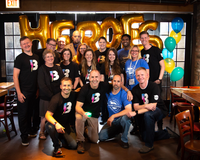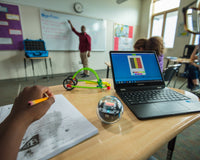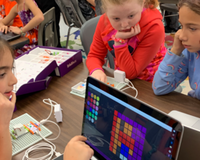To further their education in STEM, students often need to challenge themselves and be challenged by their teachers. Tackling an advanced STEM project — one that requires the application of different high-level skills — can be hugely rewarding, but we know that it can be difficult to know where to begin.
Sphero’s coding robots and engineering equipment are a great way for educators to challenge their students with advanced STEM projects that help engage students with real-world connections. For example, all Sphero programmable robots are accompanied by detailed lesson plans ranging from the introduction of basic concepts to difficult challenges like writing JavaScript code. RVR+ can even be expanded with third-party hardware for infinite development possibilities.
This article provides advanced STEM project ideas for for middle and high schoolers using Sphero coding robots and the Blueprint Build system. Most have a wide range of suitable ages and can be adjusted to suit different learning levels and requirements.
Advanced Programming with Sphero BOLT
Ball games can be simple, but they don’t have to be. Sphero BOLT is a robotic ball that lets students express their creativity while developing higher-level coding skills. With its intricate sensors, programmable LED matrix, and sturdy design, Sphero BOLT facilitate many advanced STEM projects, typically for grades 5–9. More experienced students can push Sphero BOLT to its full potential with block coding and learn important coding concepts like variables, functions, and if/then controls, eventually using the Text Canvas editor to program their Sphero BOLT with JavaScript syntax.
Flashlight Function Tug o’ War
This one-hour activity is an advanced project for students who have nearly mastered block coding. The aim is to program Sphero BOLT for a game of flashlight-powered tug o’ war. During the game, two teams must try to react quickest by shining their flashlight at the BOLT’s light sensor when it faces their direction. The light will cause BOLT to roll towards that team, and the team that gets the BOLT to cross their finish line wins.
Hot BOLTato and Variables
Another block coding-based one-hour activity for middle or early high school students involves making a hot potato game, in which participants toss BOLT to another student until the robot eliminates a player after a random number of tosses. Students will utilize variables, conditionals, loops, random number generation, and data types in programming. Though the game itself is simple, the challenge comes with the programming needed to play.
Hello, World!
Students who are serious about a future in computer science eventually will want to learn how to write original code. The most challenging Sphero BOLT activity in this list asks students to write their first lines of JavaScript and execute a Text program. While the basic aim of the activity is to program some scrolling text on the BOLT’s matrix, the bigger picture involves getting students comfortable with writing and editing code — even if it results in mistakes.
Connected Robotic Systems with RVR+
Sphero RVR+ is a versatile, four-wheeled programmable robot tailored for learners up to grade 12. This robot provides extensive capabilities from the moment it's unboxed, even for beginners. However, it is compatible with third-party hardware like Raspberry Pi and single-board computers, programmable using the Sphero Public SDK and API libraries, and offers nearly limitless potential for advanced users. Consequently, the RVR+ is the top choice for high school coders seeking advanced challenges.
Engineering an Apple Picker
Lesson 7 in the Sphero RVR+ Educator Guide is a programming and engineering challenge in which students will turn their RVR+ into an apple-picking robot. Part of the lesson asks students to build a physical apple-collecting device that can be fitted to the top of the RVR+, exploiting its 1-kilogram payload capacity. Students will then use Text Canvas to program the robot to collect apples from “trees” (arch-shaped structures they will build using simple materials). Delicious!
Connecting the RVR+ to a Raspberry Pi
For more proficient students in grades 7–12, connecting the RVR+ robot to a Raspberry Pi is a great way to get creative with coding, robotics, and additional hardware. Adding a tiny computer to RVR+ enables customization and a host of potential possibilities, such as adding a 2.4Ghz RC receiver that can be controlled with a transmitter.
Digital Design and Rapid Prototyping with Blueprint
Robots like Sphero BOLT and RVR+ give students an accessible route into advanced robotics and computer science. Sphero Blueprint opens up another path. The modular rapid prototyping system lets students of all levels tackle important mechanical engineering challenges, and its guides for supporting CAD certification curriula like Onshape and SolidWorks means students can learn computer-aided design skills too.
Blueprint Modifications for the RVR+
The Blueprint Simple Machines unit plan aims to teach students the fundamentals of simple machines — wheels and axles, inclined planes, levers, pulleys, screws, gears, and linkages — over two to four weeks in single-class-period increments. Building upon this knowledge and familiarity with Blueprint Build components, students can create modifications for the RVR+ robot such as trailers and winches.
Support CAD Certification Curricula with Blueprint Guides
Teachers can adapt their Blueprint teaching strategies to suit learners of different abilities. A great way to widen the scope of Blueprint Build is to challenge students to design their mechanical engineering solutions using CAD software. CAD and Blueprint go hand-in-hand: Sphero has created files for each Blueprint Build component, which means students can carry out assembly modeling of their Blueprint assemblies in any CAD package. The process works particularly smoothly with Onshape and SolidWorks.
An even higher-level project for students involves challenging them to design and 3D print add-ons for Blueprint. Using the 3D Printable Starter Accessory as a foundation, students can use their imagination to design a new part that will snap-fit with standard Blueprint components. These printed mods could be functional, decorative, or both.
Sphero robots and STEM kits are well-known among educators for their user-friendly, out-of-the-box capabilities. However, BOLT,RVR+, and Blueprint can be deployed for advanced projects that will seriously test students’ coding and engineering capabilities and show them the exciting possibilities that open up with learning STEM skills Furthermore, with the ability to integrate additional hardware like a Raspberry Pi computer or a 3D printer into an activity, teachers should have no shortage of material to truly challenge their STEM students.
Browse the full range of Sphero coding robots or the Blueprint Build Kit for more teaching inspiration.










